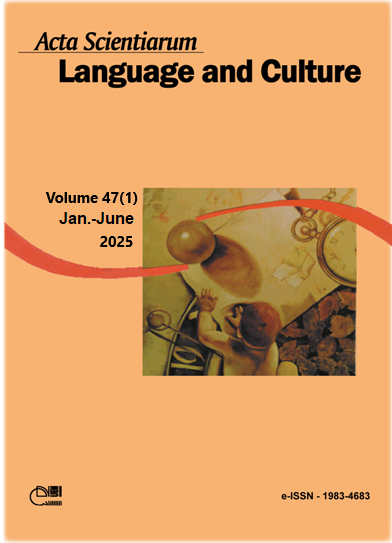A typology for purpose constructions in Portuguese
Abstract
Following Functional Discourse Grammar principles (Hengeveld & Mackenzie, 2008), the aim of this paper is to propose a typology for purpose constructions in Portuguese based centrally in the levels and layers that organize this model. The typology to be proposed here takes into consideration a description of different uses of purpose constructions in Portuguese in terms of functional and formal properties: functional properties regard aspects of the formulation of these constructions (such as level and layer of formulation of the purpose construction); as for formal properties, this paper looks to questions relating the morphosyntactic encoding of purpose constructions (as their encoding layer). Based on typologies proposed by Dias (2001), Antonio (2011), Neves (2011), Fontes (2016) and Moreira (2022), this paper investigates real usage occurrences of purpose construction, from Corpus do Português (Davies & Ferreira, 2016), and distinguishes five types of purpose constructions, two from Representational Level (eventive and epistemic) and three from Interpersonal Level (motivation, orientation and interpersonal modifiers). These different types of purpose constructions, distinguished according to the layers of Interpersonal and Representational levels, are encoded, in morphosyntactic terms, in different patterns of clause combination: while representational constructions are cases of subordination, interpersonal constructions are cases of or co-subordination or extra-clausality.
Downloads
References
Antonio, J. D. (2011). Expressão da relação retórica de propósito em elocuções formais e entrevistas orais. Calidoscópio,9(3), 206-215. https://doi.org/10.4013/cld.2011.93.05
Cristofaro, S. (2003) Subordination. University Press.
Davies, M., & Ferreira, M. (2016). Corpus do Português: Web/Dialects. http://www.corpusdoportugues.org/web-dial/
Dias, N. B. (2001). As cláusulas de finalidade [Tese de Doutorado em Linguística, Instituto de Estudos da Linguagem, Universidade Estadual de Campinas].
Dik, S. C. (Ed.). (1997). The theory of functional grammar. The structure of the clause, Part 1. Mouton de Gruyter.
Fontes, M. G. (2016) A relação finalidade em português: tipologia e funções. Cadernos de Pós-graduação em Letras, 15, 156-174.
Hengeveld, K., & Mackenzie, J. L. (2008). Functional discourse grammar: a typologically-based theory of language structure. Oxford University Press.
Jubran, C. C. A. S. (2006). Parentetização. In C. C. A. S. Jubran (Org.), Gramática do português culto falado no Brasil (Vol. I, Construção do texto falado). Contexto.
Kaltenböck, G., & Keizer, E. (2021). Insubordinate if-clauses in FDG: From modification to independence. [Abstract]. Workshop on Functional Discourse Grammar: Modification in Functional Discourse Grammar. Graz, AT.
Keizer, E. (2018). Interpersonal adverbs in FDG: the case of frankly. In E. Keizer, & H. Olbertz (Eds.), Recent developments in functional discourse grammar (pp. 48-88). John Benjamins.
Keizer, E. (2020) The semantics, syntax and prosody of adverbs in English: an FDG perspective. In A. Haselow, & G. Kaltenböck (Eds.), Grammar and cognition: dualistic models of language structure and language processing (pp. 191-231). John Benjamins.
Moreira, F. L. (2022). Orações finais introduzidas por para (que) e a fim de (que): uma abordagem discursivo-funcional [Dissertação de Mestrado. Programa de Pós-Graduação em Letras, Universidade Federal de Mato Grosso do Sul]. Biblioteca Digital da Universidade Federal de Mato Grosso do Sul. https:// https://repositorio.ufms.br/handle/123456789/5132.
Neves, M. H M. (2011). Gramática de usos do português (2a ed.). UNESP.
Pérez Quintero, M. J. (2002). Adverbial Subordination in English. A Functionalist Approach. Rodopi.
Thompson, S. A. (1985) Grammar and written discourse: initial vs. final purpose clause in English. Text - Interdisciplinary Journal for the Study of Discourse, 5(1-2), 55-84. https://doi.org/10.1515/text.1.1985.5.1-2.55
DECLARATION OF ORIGINALITY AND COPYRIGHTS
I Declare that current article is original and has not been submitted for publication, in part or in whole, to any other national or international journal.
The copyrights belong exclusively to the authors. Published content is licensed under Creative Commons Attribution 4.0 (CC BY 4.0) guidelines, which allows sharing (copy and distribution of the material in any medium or format) and adaptation (remix, transform, and build upon the material) for any purpose, even commercially, under the terms of attribution.
Read this link for further information on how to use CC BY 4.0 properly.




















6.png)









